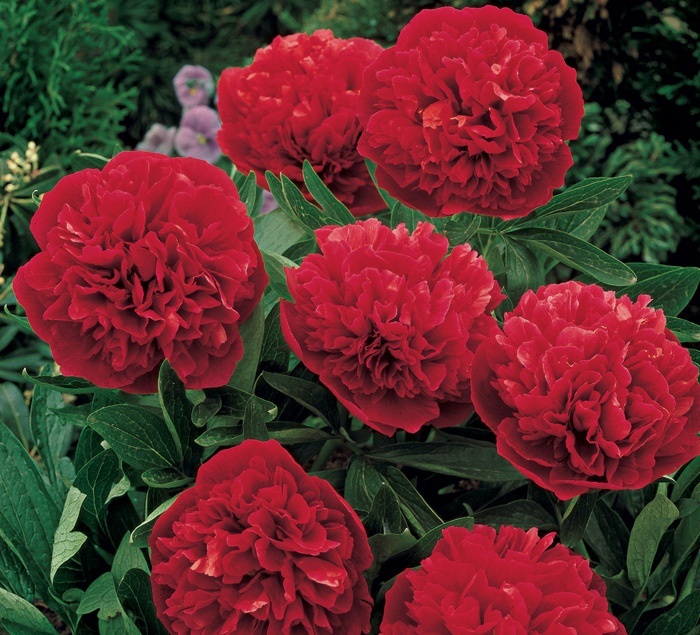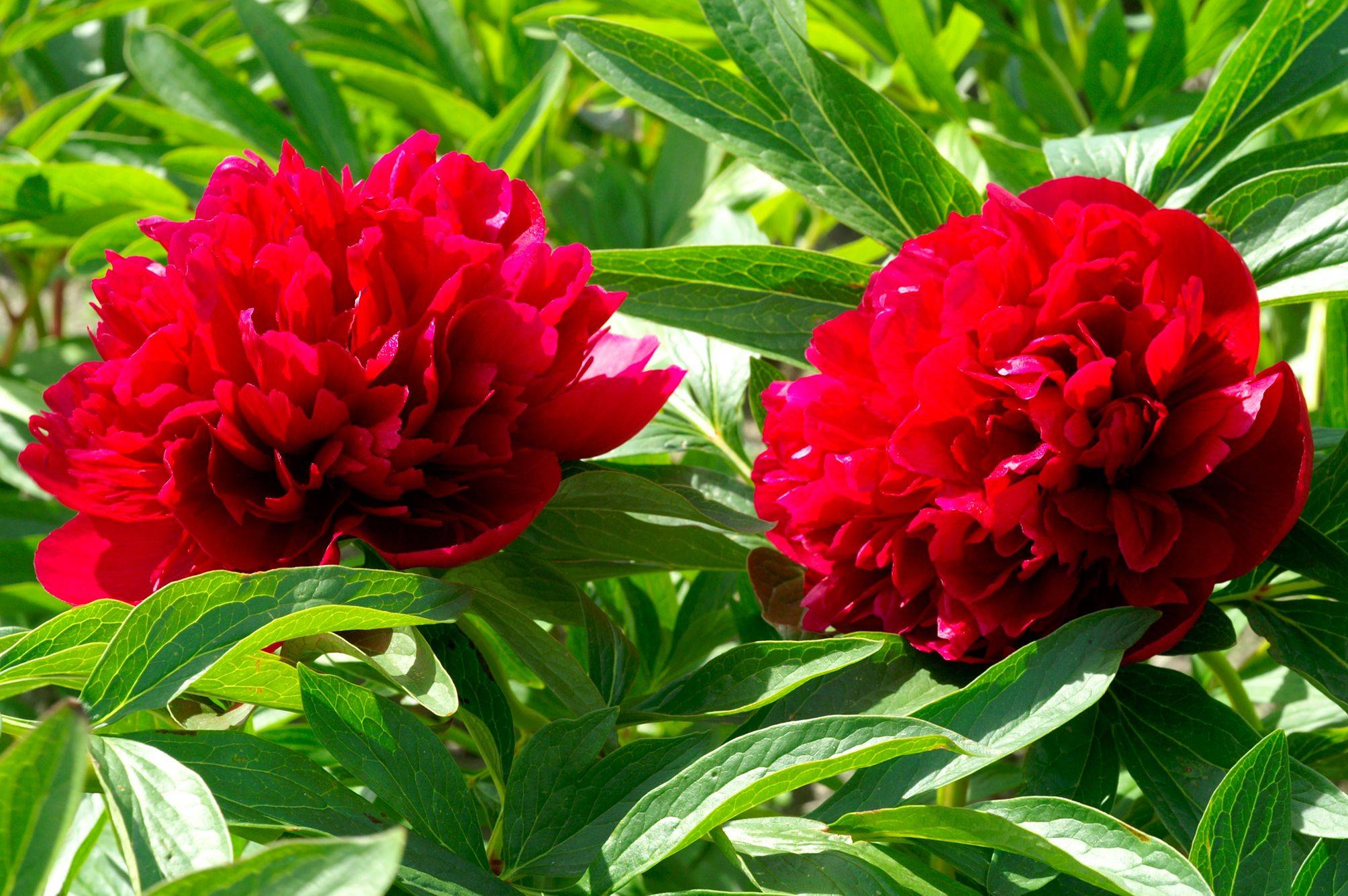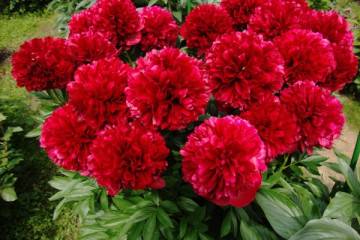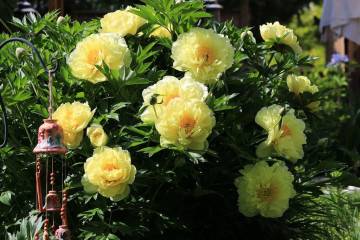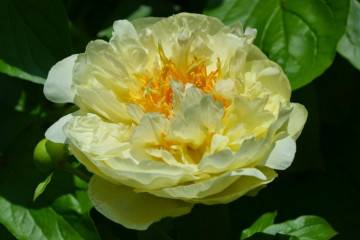Peony Rubra Plena (Paeonia Rubra Plena) - features of the variety
Content:
Peonies decorate many flower beds, gardens and flower beds. These plants are unpretentious and very decorative, while they are resistant to frost, diseases and pests. The article describes the Rubra Plena peony, one of the most common varieties.
Peony Officialis Rubra Plena (Paeonia Officinalis Rubra Plena) - what is this variety, history of creation
Herbaceous perennial shrub. Rhizomes and petals have medicinal properties. Stem height up to one meter. Large single flowers up to 15 cm in diameter, double. The color of the glossy petals is ruby. The fully opened flower is in the shape of a ball. Over time, the outer petals brighten. The buds exude a light pleasant aroma.
Brief description, characteristic
The compact shrub is made up of thick, slightly curved shoots and large, dark green, palmate leaves. Peony stems are strong, but during flowering it will be correct to provide them with support.
Powerful fleshy root tubers of the plant are located deep enough in the soil, so the plant easily tolerates frosts down to -40 ° C without additional insulation.
Seeds of Rubr Plena officinalis are almost black, oval in shape, collected in a capsule fruit.
Flowering amicable, but short, only 2-2.5 weeks. At the same time, 25-30 silk flowers with a delicate aroma can open on the bush.
Advantages and disadvantages of the variety
Like any other, the flower has its pros and cons.
Benefits:
- blooms together;
- decorative;
- frost-resistant;
- unpretentious.
Disadvantages:
- flowering period 2-3 weeks.
Use in landscape design
Peony Officinalis Rubra plena is used:
- in groups with other varieties;
- in groups with other varieties of flowers;
- as free-standing plants.
Growing a flower, how to plant it in open ground
In order for the Rubra Plena peony to bloom on the site, you do not need special exquisite measures, but it is imperative to follow agricultural techniques.
Planting by root cuttings
Root cuttings - areas of rhizome, 2-5 cm long, necessarily containing a bud and root. Planting material is prepared in July-August. Algorithm of actions:
- Dig up the rhizome, remove old roots and earth.
- Divide the rhizome into cuttings with at least 1 bud and 1 root.
- Disinfect the cuttings by soaking for 2 hours in a pink solution of potassium permanganate.
- Dry the cuttings, roll the slices in crushed activated carbon, leave overnight.
- In a dug up and fertilized bed, plant the cuttings at a distance of 15 cm from each other.
The plantings are shaded from the sun, watered regularly, weeded as needed, insulated for the winter. Such peonies will bloom in 3 years.
What time is the boarding
Most often, the thin-leaved peony Rubra Plena is propagated by dividing the rhizome.Best of all, the plant will tolerate manipulations in late April - early May, or late August - early September. During these periods, a nutritious root system is laid, those roots that suck water from the soil.
Location selection
Bushes can grow and bloom in one place for up to 30 years. The main thing is that it is correctly selected and meets the following conditions:
- a lot of light, the peony will not bloom in the shade;
- nutritious soil, loamy;
- groundwater must be deep, otherwise drainage of the soil;
- do not plant bushes near other perennials, walls of buildings.
How to prepare the soil and flower for planting
The landing site is prepared in 3-4 weeks:
- Dig a hole with a depth and diameter of 60 cm.
- Drainage is organized (expanded clay, pebbles, broken brick).
- The hole is filled ½ with soil, forming a mound.
Plant preparation:
- The stems are cut off the bush.
- Carefully dig out the rhizome.
- The soil is cleaned from the roots so that the buds become visible.
- The accessory roots are cut, leaving 10-12 cm.
- Rotten, dried out areas are removed by sprinkling the cuts with crushed coal.
- The rhizome is divided into parts with a pruner (sharp knife) so that in each division there are 2 adventitious roots and 2-3 developed buds.
Planting procedure step by step
Landing is carried out according to the following algorithm:
- Part of the rhizome is placed in a prepared and well-watered hole.
- The upper kidney is positioned level with the ground.
- The hole is covered with soil, compacted.
- Mulch the landing site.
- Water abundantly.
Planting with seeds (for breeding)
Getting seeds is troublesome, many hybrids do not bear fruit at all. Features of seed reproduction of peonies:
- seeds sprout tightly and uncommonly;
- only every fifth seed germinates;
- peonies grown from seeds will bloom for 6-7 years;
- the collection of seeds is carried out in August.
After landing in wet sand, a two-stage stratification is carried out:
- Thermal. The sand with seeds is heated twice to +30 ° C. Between and after heating, the sand is watered.
- Cold. When the seeds sprout in the sand, they are transferred to peat pots. The seedlings are kept at a temperature of + 5 ... + 10 ° С for about 3 months.
After stratification, the seedlings are transferred to a room where they stand until May - the time of transplanting into open ground.
Plant care
Caring for a peony is simple, but certain features must be observed.
Watering and feeding
In the spring, at the beginning of flowering, watering should be infrequent, but abundant. 2-3 buckets of water are poured under each bush. During this period, phosphorus-potassium fertilizers are applied.
Mulching and loosening
Agrotechnical measures will improve soil structure and root respiration. Bark, cut grass, expanded clay are used as mulch. Loosening several times per season, while removing weeds.
Blooming peony Rubra Plena
During the flowering period, the peony needs a little more attention than usual.
A period of activity and rest
All peonies have two periods of active root growth. In the spring, after the soil temperature rises to +5 ° C and until the end of flowering. In autumn, when the suction roots turn into storing rhizomes, thanks to which the plant hibernates.
Care during and after flowering
At the very beginning of flowering, the side buds on the bush are removed, thanks to which the remaining buds will bloom faster and will be larger.
During flowering, potash-phosphorus fertilizers are applied. After the peony has blossomed - organic.
Faded buds are cut with a sharp pruner, leaving some of the stems on the bush. The plant needs the stems to store the maximum nutrients for the winter. Fallen petals must be removed from the ground around the bush as a preventive measure for diseases.
What to do if it does not bloom, possible reasons
The list of factors by which the plant may not bloom:
- bush younger than 2 years old;
- the place was chosen incorrectly (the peony is dark, humid);
- strong deepening when landing;
- the plant needs rejuvenation, transplantation to a new place;
- excess nitrogen fertilizers (powerful greens of rich green color);
- acidic soil;
- defeat by root nematodes.
Peonies after flowering
A peony that has finished blooming needs to recuperate; at this time, special agricultural techniques are required.
Pruning
In no case should the leaves be cut off immediately after flowering, otherwise the flower will not prepare for winter, it will not lay flower buds.
Preparing for winter
In autumn, when the tops of the peony turn yellow and wither, they are completely cut off and burned to prevent diseases. Sprinkle the soil in place of the bush with ash.
Diseases, pests and ways to control them
The Peony Peony is rarely affected by diseases and pests. In rare cases, if agricultural technology is violated, it can be affected by gray, root rot, rust. All these are fungal diseases. Fight:
- establish an irrigation regime;
- treat the bushes with a fungicide or Bordeaux liquid;
- do not forget about the autumn pruning and burning of the tops.
Insects that can infect a peony are aphids, spider mites. A strong soap solution, an infusion of garlic, and, in extreme cases, systemic pesticides will help against them. Gall nematodes are especially dangerous for peony. There are no methods of dealing with nematodes. A sick bush is dug up and burned.
Peony is one of the most popular garden plants. Bouquets from it are beautiful and stand in vases for a long time. They are loved for their healing properties: decoctions and infusions of roots and petals are used to treat diseases of the cardiovascular system, as a wound healing agent.
